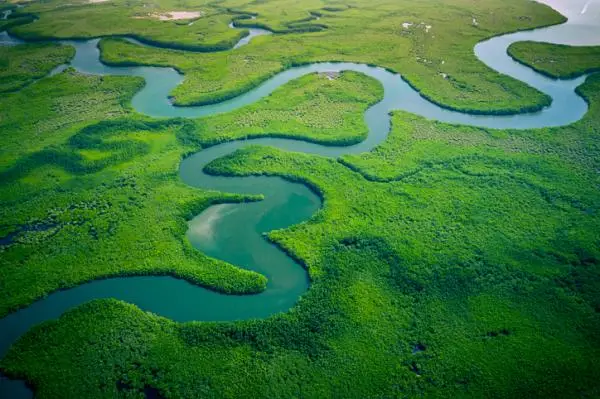When we study the hydrography of a country or a specific territory, we discover different continental water masses that are well-called rivers or tributaries. But do we know what they are? What is the difference between them?
It is true that there is often a certain degree of confusion regarding the definition of both terms. Therefore, if you want to solve your doubts, we recommend that you continue reading this article about what a tributary is, where you can consult from the definition of a tributary to its differences with rivers and effluents and learn about some tributaries in the world.
What are tributaries and their characteristics
The tributaries are secondary rivers that join in a confluence zone to other main rivers , on which they flow. Among the characteristics of the tributaries we highlight:
- As we see in the definition, we usually refer to tributaries under the term “river” but, without going any further, both concepts do not mean the same thing, as shown in the following sections. Despite the fact that there are tributaries that can have the same dimensions as a river, they generally tend to be shorter in length and have a fluvial regime characterized by a lower flow.
- Another characteristic of the tributaries is that to determine their location one speaks of the river banks; that is, the tributaries that are on the left bank of the river are distinguished from those that are located on the right bank.
Taking into account the amount of tributaries in a river basin , the Strahler method allows ranking the drainage network using orders, in order to easily identify and classify watercourses:
- The courses of order 1 or of the first order are those that lack tributaries, so they would be main unbranched rivers.
- The courses of order 2 or of second order are formed when two courses of first order converge.
- The courses of order 3 or of third order are formed by the union of rivers of second order.

What is the difference between a river and a tributary
In both cases, we are dealing with bodies of water that are running or circulating continuously. But, what is it that differentiates these two elements of the hydrographic basin?
First, it is necessary to be clear that the fundamental structure of the hydrographic basins are the rivers and that the tributaries are one more part that constitutes them. To this is added that they differ in the final destination of their waters . That is to say, the rivers end up flowing into the sea , the lakes or the oceans; while, the waters of the tributaries go to the main river . Furthermore, as we have introduced in the previous section, the tributaries are usually smaller, have a lower flow and also have a smaller reception basin than that of the main rivers.
What is the difference between tributary and effluent
Depending on the direction that the watercourse takes, the small rivers that are linked to the main rivers are manifested as:
- Tributaries or tributaries: they are smaller rivers that feed the main river (they discharge their waters into it).
- Effluents or emissaries: they are rivers whose water comes or derives from the main current; that is, the water from the main river ends up being distributed to smaller rivers. Unlike tributaries, there are not always effluents in basins.
Names of tributaries of Spain
In Spain there are eight main rivers: the Miño, Ebro, Duero, Tajo, Júcar, Guadiana, Segura and Guadalquivir. Despite being large rivers, each one has different peculiarities, so there is no standard length or flow that defines them. Such rivers have their own tributaries, their own hydrographic basin and flow into a certain slope.
Below are examples of river tributaries in Spain :
- Tributaries of the Guadiana River: El Cigüela, Záncara, Bullarque, Bañuelos, Guadiana Alto, Azuer and Córcoles.
- Tributaries of the Duero River: Pisuerga, Esla, Araja, Tormes and Eresma.
- Tributaries of the Tagus River: Jarama, Alagón, Alberche, Tiétar and Salor.
- Tributaries of the Ebro river: Nelas, Bayas, Zadorra, Aragón, Izarilla, Najerilla, Gallego, Guadalope, Segre and Jalón.
- Most important tributaries of the Guadalquivir river: Guadiana Menor, Guadalbullón, Guadajoz, Genil, Guadaíra and Tamarillo.

Names of tributaries of the Nile River
The Nile River, whose waters flow into Lake Victoria, is one of the longest rivers in the world. It crosses 11 African countries and, together with its tributaries, this main river has a length of approximately 3 million kilometers.
It has two important tributaries: The White Nile and The Blue Nile . But they are not the only ones, there are other tributaries of the Nile that stand out, such as: Atbara river, Sobat, Abbay, Tekezé, Baro and Semliki river.

Names of tributaries of the Amazon River
In terms of volume of water, according to FAO, the Amazon is considered the largest river in the world . Crossing Peru and Brazil, there is an extensive system of tributaries or tributaries of the Amazon River :
- In the northern region, the following tributaries stand out: Santiago, Morona, Pastaza, Tigre, Putumayo-Iça, Caquetá,, Negro, Urubu, Japurá, Napo, Nhamundá, Trombetas, Curuá, Maicurú, Paru, Jarí and Maracá
- In the southern region we find the tributaries: Ucayali, Javarí, Huallaga, Jandiatuba, Jutaí, Juruá, Tefé, Coarí, Purus, Madeira, Tapajós, Xingú, Anapu, Pacaja and Jacunda.

